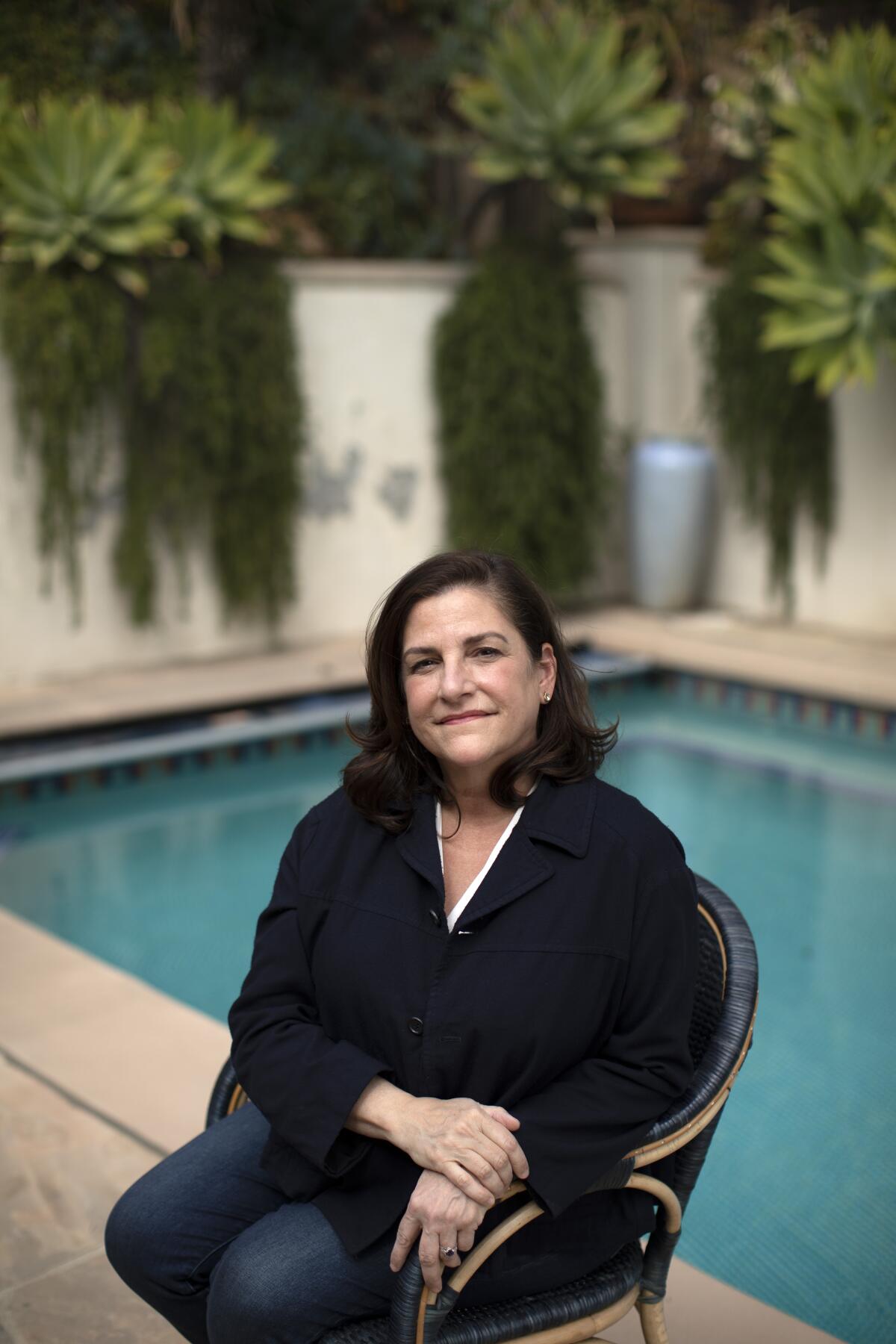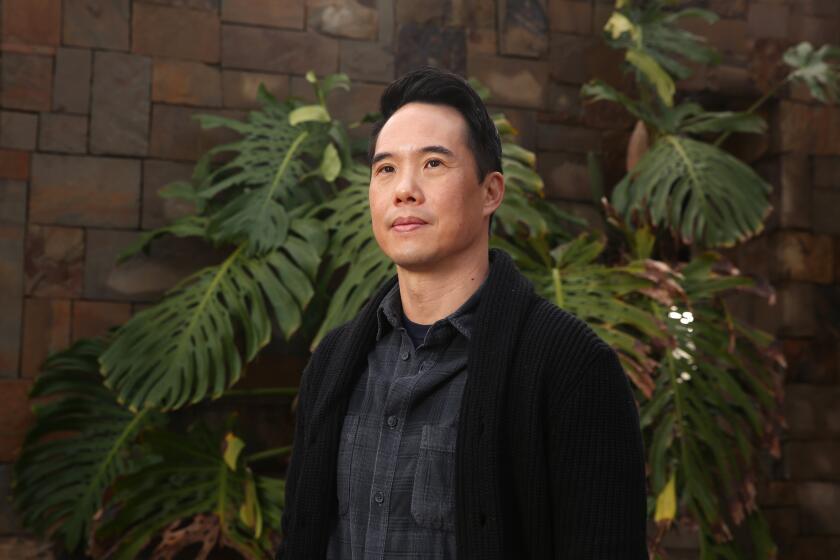In life and fiction, a late-blooming novelist makes peace, happily, with L.A.

- Share via
On the Shelf
Good Company
By Cynthia D’Aprix Sweeney
Ecco: 320 pages, $28
If you buy books linked on our site, The Times may earn a commission from Bookshop.org, whose fees support independent bookstores.
The novelist Cynthia D’Aprix Sweeney turned 60 last August. How did she celebrate?
“I cooked dinner for my family,” she recalls with an only slightly rueful smile.
Sweeney and her husband, Mike, a longtime head writer for Conan O’Brien, left their New York City home in 2009 for Los Angeles. While COVID has put a damper on big birthday plans, Sweeney is surprisingly sanguine about life in Los Feliz. “I can walk in Griffith Park, for example,” she tells me via video call. “We’ve been able to see friends outside on our patio.” One of their two sons works in food service but “just got the vaccine. That was a happy moment for our family.”
It’s been a happy few years for Sweeney, pandemic and dislocation notwithstanding. Her debut novel, “The Nest,” came out in 2016, when she was 55 — and had just finished her MFA at Bennington Writing Seminars. Acclaimed as “fetching,” “biting and addictive,” “The Nest” became a bestseller and was optioned by Amazon Studios. Such success might lead a writer to stress over the dreaded sophomore slump. Not Sweeney.
“I want people to like it; I hope they see what’s good about it,” she says of “Good Company,” her new novel about an acting troupe and a marriage in trouble. “But I wrote the book I wanted to write. No book can be good for everyone. I feel pretty great about it, to be honest.”
The strife and self-doubt of middle age — that went into the book. “I don’t think it’s any surprise that shortly after I did something in midlife that changed my life — getting my MFA, moving across the country — that I found myself writing a novel about hitting a moment in life when not everything is possible anymore.”
The two longtime couples at the center of “Good Company” each hit the wall of the empty nest. “If you have kids and they go off to college or careers, it’s a sort of reassessment period for a marriage.”
Over the past 20 years, industry shifts have funneled more novelists into TV rooms than ever. It’s salutary in many ways — beginning with health insurance.
Spoiler alert: Sweeney’s marriage survived her own reassessment. “I married someone whose career took off while mine was just going along at the same pace,” she says. “It was very evident, when we had children, who was going to stop working because I wasn’t making enough money to support a family.”
Along came “The Nest” to lift Sweeney out of her empty nest and level the playing field of her marriage. And they had already made — and learned from — the big move.
“When we relocated to Los Angeles, I had to move six months ahead of my husband so our oldest son could start high school in his new city,” she says. “Mike was alone in Brooklyn; I was alone with two kids in L.A. It was a complete nightmare, and we learned how not to act when separated by 3,000 miles, information that I hope never to have to use.”

By the time the dust cleared and Sweeney looked around, some of her peers weren’t so lucky. “A weird thing happened as I was starting to work on ‘Good Company,’” she says. “A lot of my friends started to get divorced. And I remember thinking, oh, I thought we were all smarter than that, that that’s why we got married later.”
She funneled their discontent into the novel, along with something that actually did happen to her — a small loss, in the scheme of things, that provides the novel’s opening beat and abiding symbol. What else could it be but a wedding ring?
“I’d been working on this book in its early stages and was feeling kind of depleted after the paperback tour for ‘The Nest,’” Sweeney recalls. “A friend suggested taking the summer off, and I did, so I went on a business trip with my husband to Israel. I left my engagement ring and wedding ring in the hotel room and never got them back.”
Sweeney’s wedding band had belonged to her grandmother. “Just this tiny little worn-down white-gold band,” she says. “No amount of insurance could replace it.” On her return, she heard so many stories from other people about lost pieces of jewelry that a long-lost ring felt like a resonant way to start a story about lifelong bonds breaking apart.
With a new memoir, “You’re Leaving When?,” the writer-actress contemplates illness, middle age and an empty nest, humorously.
“Good Company’s” protagonist, Flora Mancini, finds an envelope containing a photo — as well as the wedding ring her husband of 20 years said he lost in a pond long ago. The story of the ring prompts a narrative flashback to the couple’s salad days, as they struggled to keep Julian’s New York theater, Good Company, in the black — then flashes forward to their move to Los Angeles after Flora lands a stable and lucrative voice-over gig on an animated sitcom.
Moving to L.A. also means reconnecting with Flora’s even more successful best friend, actor Margot Letta, whose partner, David, is a cardiologist recovering from a severe stroke. When Flora and Julian’s daughter Ruby (“my favorite character,” Sweeney says) graduates from high school, David presents her with a jewel, a tiny gold human heart that opens to reveal the girl’s namesake gemstone. And yet another significant piece of jewelry reminds the couple of what’s always been at stake in their union.
Over the course of “Good Company,” two unions are tested. Whatever their fates, Sweeney felt it was important to recognize that from the vantage point of middle age in the 21st century, the end of a marriage is not always synonymous with failure. “Any relationship that lasts long enough to make the participants happy and possibly create a family is successful,” she says. “If people in a relationship find they want different things, that doesn’t negate what’s come before.”
“Good Company” is a quieter, more wistful novel than “The Nest” — the California counterpart to the first novel’s very New York drama. With its inheritance plot, real-estate frenzy and aura of zero-sum conflict, “The Nest” was sharp and funny, noisy and big. Sweeney embarked on her second novel with the goal of lingering longer with her characters and going a little deeper. “I wanted it to be a more focused kind of book.”
One continuity between the two books is the centrality of family — something always on Sweeney’s mind. She and her three siblings remain close; her mother’s extended Italian family was happy and all-enveloping, with a grandmother who had seven siblings and grandfather who had nine. When I say it sounds like the inspiration for her fictional theater troupe, she says, “That’s a good comparison, because everyone had their own role. ‘The Nest’ is about the family you are born into versus the family you choose, while ‘Good Company’ is about choosing how you make your family.”
Sweeney’s next book will likely circle back to the root of her family fixation — her original hometown of Rochester, N.Y. Will it be the Great Rochester Novel we never knew we needed? “Maybe!” she says with a laugh. “My first novel was definitely all about New York. I’d hoped my second would be more about California, but it’s kind of a hybrid. I’m just not finished with the East Coast, I guess.”
But for the moment, she’s happy where she is.
Readers thought Stephanie Danler’s debut novel, “Sweetbitter,” was autobiography. The reality, in her memoir “Stray,” is far more painfully dramatic.
Patrick is a freelance critic who tweets @TheBookMaven.
More to Read
Sign up for our Book Club newsletter
Get the latest news, events and more from the Los Angeles Times Book Club, and help us get L.A. reading and talking.
You may occasionally receive promotional content from the Los Angeles Times.









